
History of Coventry
Encyclopedia
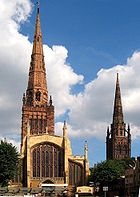
Coventry
Coventry is a city and metropolitan borough in the county of West Midlands in England. Coventry is the 9th largest city in England and the 11th largest in the United Kingdom. It is also the second largest city in the English Midlands, after Birmingham, with a population of 300,848, although...
, a city in the West Midlands
West Midlands (region)
The West Midlands is an official region of England, covering the western half of the area traditionally known as the Midlands. It contains the second most populous British city, Birmingham, and the larger West Midlands conurbation, which includes the city of Wolverhampton and large towns of Dudley,...
, England
England
England is a country that is part of the United Kingdom. It shares land borders with Scotland to the north and Wales to the west; the Irish Sea is to the north west, the Celtic Sea to the south west, with the North Sea to the east and the English Channel to the south separating it from continental...
.
From its humble beginnings as a settlement around a Saxon
Anglo-Saxon
Anglo-Saxon may refer to:* Anglo-Saxons, a group that invaded Britain** Old English, their language** Anglo-Saxon England, their history, one of various ships* White Anglo-Saxon Protestant, an ethnicity* Anglo-Saxon economy, modern macroeconomic term...
nunnery c. AD 700, Coventry grew to become one of the most important cities in England during the Middle Ages
Middle Ages
The Middle Ages is a periodization of European history from the 5th century to the 15th century. The Middle Ages follows the fall of the Western Roman Empire in 476 and precedes the Early Modern Era. It is the middle period of a three-period division of Western history: Classic, Medieval and Modern...
due to its booming cloth and textiles trade. The city was noted for its part in the English Civil War
English Civil War
The English Civil War was a series of armed conflicts and political machinations between Parliamentarians and Royalists...
, and later became an important industrial city during the 19th and 20th centuries, becoming the centre of the British bicycle
Bicycle
A bicycle, also known as a bike, pushbike or cycle, is a human-powered, pedal-driven, single-track vehicle, having two wheels attached to a frame, one behind the other. A person who rides a bicycle is called a cyclist, or bicyclist....
and later motor industry. The devastating Blitz
Coventry Blitz
The Coventry blitz was a series of bombing raids that took place in the English city of Coventry. The city was bombed many times during the Second World War by the German Air Force...
in 1940 destroyed most of the city centre, and saw its rebuilding during the 1950s and 60s. The motor industry slumped during the 1970s and 80s, and Coventry saw high unemployment.
Beginnings
Little is known of the earliest history of Coventry, but prior to its existence there were settlements in nearby CorleyCorley
Corley is a village and civil parish in the North Warwickshire district of Warwickshire, England. It is located about northwest of Coventry and is adjacent to the village of Fillongley. The M6 motorway runs close by, and the village is familiar to motorists as it is the site of Corley Services...
and Baginton
Baginton
Baginton is a village and civil parish in the Warwick district of Warwickshire, England, and has a common border with the City of Coventry of the West Midlands county. With a population of 801 , Baginton village is four miles south of Coventry city centre and seven miles north of...
, which came to be occupied by the Romans
Roman conquest of Britain
The Roman conquest of Britain was a gradual process, beginning effectively in AD 43 under Emperor Claudius, whose general Aulus Plautius served as first governor of Britannia. Great Britain had already frequently been the target of invasions, planned and actual, by forces of the Roman Republic and...
, and later by Saxon invaders. These locations were probably chosen because they lay on early trackways, and were situated on light, easily worked soil free from thick forest and undergrowth; unlike the heavy clay soil, covered in marsh and forest near the north-eastern reaches of the Forest of Arden
Arden, Warwickshire
Arden is an area, mainly located in Warwickshire, England, traditionally regarded as stretching from the River Avon to the River Tame.-History:...
on which Coventry would rise.
It is likely that the first settlement here grew around a Saxon nunnery which had been founded c. AD 700 by St. Osburga. With the forest being mostly unsuitable for the cultivation of crops, the Saxon settlers would have cleared the land and concentrated on raising cattle and sheep, eventually leading to Coventry's successful wool industry and great wealth. The name "Coventry" would have had its origins at this time and has had several forms of spelling, as well as many theories regarding its meaning, but "Cofa's tree" is thought to be a most likely source of the name. Nothing is known of Cofa, but a tree planted by, or named after him may have marked the centre or the boundary of the settlement. An alternative favoured by some is "Coventre" – derived from the words "Coven" (old variation of "Convent") and "tre" (celtic: "settlement" or "town"), giving rise to "Convent Town".
A third hypothesis is that the word Coventry is derived from the word 'coven' meaning a collection of witches.
Origins of St. Mary's Priory and Cathedral
The first chronicled event in the history of Coventry took place in 1016 when King CanuteCanute the Great
Cnut the Great , also known as Canute, was a king of Denmark, England, Norway and parts of Sweden. Though after the death of his heirs within a decade of his own and the Norman conquest of England in 1066, his legacy was largely lost to history, historian Norman F...
and his army of Danes were laying waste to many towns and villages in Warwickshire in a bid to take control of England, and on reaching the settlement of Coventry they destroyed the Saxon nunnery. Leofric, Earl of Mercia
Leofric, Earl of Mercia
Leofric was the Earl of Mercia and founded monasteries at Coventry and Much Wenlock. Leofric is remembered as the husband of Lady Godiva.-Life and political influence:...
and his wife Lady Godiva
Lady Godiva
Godiva , often referred to as Lady Godiva , was an Anglo-Saxon noblewoman who, according to legend, rode naked through the streets of Coventry in order to gain a remission of the oppressive taxation imposed by her husband on his tenants...
(a corruption of her given name, "Godgifu") rebuilt on the remains of the nunnery to found a Benedictine
Order of Saint Benedict
The Order of Saint Benedict is a Roman Catholic religious order of independent monastic communities that observe the Rule of St. Benedict. Within the order, each individual community maintains its own autonomy, while the organization as a whole exists to represent their mutual interests...
monastery
Monastery
Monastery denotes the building, or complex of buildings, that houses a room reserved for prayer as well as the domestic quarters and workplace of monastics, whether monks or nuns, and whether living in community or alone .Monasteries may vary greatly in size – a small dwelling accommodating only...
in 1043 dedicated to St. Mary for an abbot and 24 monks. Leofric had been appointed Earl by Canute and was one of the three most powerful men in the country, while Godiva was already a woman of high status before marriage and owned much land.
Edward the Confessor
Edward the Confessor
Edward the Confessor also known as St. Edward the Confessor , son of Æthelred the Unready and Emma of Normandy, was one of the last Anglo-Saxon kings of England and is usually regarded as the last king of the House of Wessex, ruling from 1042 to 1066....
, who had been crowned king by this time, favoured pious acts of this nature and granted a charter confirming Leofric and Godiva's gift.
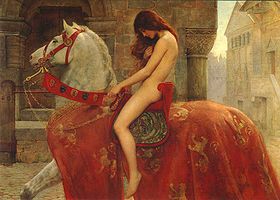
Bishop Robert de Limesey
Robert de Limesey
Robert de Limesey was a medieval Bishop of Chester. He moved the see from Chester to Coventry in 1102....
transferred his see
Episcopal See
An episcopal see is, in the original sense, the official seat of a bishop. This seat, which is also referred to as the bishop's cathedra, is placed in the bishop's principal church, which is therefore called the bishop's cathedral...
to Coventry c. 1095, and in 1102 papal authorisation for this move also turned the monastery of St. Mary into a priory and cathedral
St. Mary's Priory and Cathedral
St Mary's Priory and Cathedral was a religious institution in Coventry, England, founded in the 12th century by transformation of the former monastery of St Mary, and destroyed during the Dissolution of the Monasteries in the early 16th century...
. The subsequent rebuilding and expansion of St. Mary's was completed about 125 years later.
In February 2000, Channel 4
Channel 4
Channel 4 is a British public-service television broadcaster which began working on 2 November 1982. Although largely commercially self-funded, it is ultimately publicly owned; originally a subsidiary of the Independent Broadcasting Authority , the station is now owned and operated by the Channel...
's Time Team
Time Team
Time Team is a British television series which has been aired on Channel 4 since 1994. Created by television producer Tim Taylor and presented by actor Tony Robinson, each episode features a team of specialists carrying out an archaeological dig over a period of three days, with Robinson explaining...
archaeologists discovered significant remnants of a major pre-Tudor cathedral/monastery complex (St Mary's) adjacent to the current cathedral, with the team revisiting the excavation site in March 2001.
When the monastery was founded, Leofric gave the northern half of his estates in Coventry to the monks to support them. This was known as the "Prior's-half", and the other was called the "Earl's-half" which would later pass to the Earls of Chester
Earl of Chester
The Earldom of Chester was one of the most powerful earldoms in medieval England. Since 1301 the title has generally been granted to heirs-apparent to the English throne, and from the late 14th century it has been given only in conjunction with that of Prince of Wales.- Honour of Chester :The...
, and explains the early division of Coventry into two parts (until the Royal "Charter of Incorporation" was granted in 1345). In 1250, Roger de Mold (referred to in older documents as "Roger de Montalt"), the earl at the time who had gained his position by marriage, sold his wife's rights and estates in the southern side of Coventry to the Prior, and for the next 95 years the town was controlled by a single "land lord". However, disputes arose between the monastic tenants and those previously of the Earl, and the Prior never gained complete control over Coventry.
Coventry's castle
Coventry CastleCoventry Castle
Coventry Castle was a motte and bailey castle in the city of Coventry, England .It was built in the 11th century by Ranulf Meschines, Earl of Chester, probably out of wood initially...
was originally built towards the end of the 11th century by Ranulph le Meschin, 1st Earl of Chester, but was razed to the ground in the 12th century. It was rebuilt around 1137 to 1140 by Ranulph de Gernon, 2nd Earl of Chester
Ranulph de Gernon, 2nd Earl of Chester
Ranulf II was an Anglo-Norman potentate who inherited the honour of the palatine county of Chester upon the death of his father Ranulf le Meschin, 3rd Earl of Chester...
, who successfully held it against King Stephen
Stephen of England
Stephen , often referred to as Stephen of Blois , was a grandson of William the Conqueror. He was King of England from 1135 to his death, and also the Count of Boulogne by right of his wife. Stephen's reign was marked by the Anarchy, a civil war with his cousin and rival, the Empress Matilda...
during the civil war known as The Anarchy
The Anarchy
The Anarchy or The Nineteen-Year Winter was a period of English history during the reign of King Stephen, which was characterised by civil war and unsettled government...
("Barons Wars" or "The Nineteen-Year Winter"). Although the exact location of the castle is unknown, Broadgate, Coventry's city centre, refers to the "broad gate" or main approach to the castle which therefore must have been situated in its vicinity.
In time, merchants and tradesmen settled around the monastery and castle, a market
Market
A market is one of many varieties of systems, institutions, procedures, social relations and infrastructures whereby parties engage in exchange. While parties may exchange goods and services by barter, most markets rely on sellers offering their goods or services in exchange for money from buyers...
was established at the monastery gates, new houses multiplied and two churches were built: Holy trinity
Holy Trinity Church, Coventry
Holy Trinity Church, Coventry is a parish church in the Church of England located in Coventry City Centre, West Midlands, England.Above the chancel arch is probably the most impressive Doom wall-painting now remaining in an English church.-History:...
for the tenants of the Prior's-half, and St. Michael's for those living in the Earl's-half. From then on Coventry began to develop a more organised layout; streets appeared and, similar to London and other old cities, trading quarters came into being.
Ranulf was succeeded as earl by his rebellious son, Hugh de Kevelioc, 3rd Earl of Chester
Hugh de Kevelioc, 3rd Earl of Chester
Hugh de Kevelioc, 5th Earl of Chester was the son of Ranulf de Gernon, 4th Earl of Chester and Maud of Gloucester, daughter of Robert, 1st Earl of Gloucester .-Early life:He is thought to have been born Kevelioc in Monmouth...
, who in 1173 held Coventry's castle against King Henry II
Henry II of England
Henry II ruled as King of England , Count of Anjou, Count of Maine, Duke of Normandy, Duke of Aquitaine, Duke of Gascony, Count of Nantes, Lord of Ireland and, at various times, controlled parts of Wales, Scotland and western France. Henry, the great-grandson of William the Conqueror, was the...
. Henry sent a strong force to Coventry, which almost certainly severely damaged the castle. Over the years, what remained of the castle fell into disuse and eventually disappeared, and from the 13th century the manor house at Cheylesmore
Cheylesmore
Cheylesmore is a suburb in the southern half of the city of Coventry, West Midlands, England. It is one of Coventry's largest suburbs, sharing borders with Whitley and Stivichall in the South, extending into Coventry city centre and bordering with Earlsdon in the North. Cheylesmore has two...
took its place as the earls' residence.
One of the last mentions of the castle was in 1569, following the Catholic Rising of the North
Rising of the North
The Rising of the North of 1569, also called the Revolt of the Northern Earls or Northern Rebellion, was an unsuccessful attempt by Catholic nobles from Northern England to depose Queen Elizabeth I of England and replace her with Mary, Queen of Scots.-Background:When Elizabeth I succeeded her...
: Mary Queen of Scots was rushed south from Tutbury Castle
Tutbury Castle
Tutbury Castle is a largely ruinous medieval castle at Tutbury, Staffordshire, England, in the ownership of the Duchy of Lancaster. It is a Grade I listed building...
to Coventry. Elizabeth I sent a letter, instructing the people of Coventry to look after Mary. She suggested that Mary be held somewhere secure such as Coventry Castle
Coventry Castle
Coventry Castle was a motte and bailey castle in the city of Coventry, England .It was built in the 11th century by Ranulf Meschines, Earl of Chester, probably out of wood initially...
. However, by that time it was too decayed and Mary was instead first held at the Bull Inn, Smithford Street before being moved to the Mayoress's Parlour in St. Mary's Guildhall. Following the defeat of the rebels, Mary was once more sent north to Chatsworth
Chatsworth
-Places:Australia* Chatsworth, Queensland* Electoral district of Chatsworth, Queensland, AustraliaCanada* Chatsworth, Ontario, a township* Chatsworth, Ontario , located within above townshipSouth Africa* Chatsworth, Durban* Chatsworth, Western Cape...
in May 1570.
Growth and prosperity
Coventry may have remained a place of little importance had it not been for the benefaction of Leofric and Godiva in founding the monastery; however, its growth was also assisted by other factors. Running through the town was the River SherbourneRiver Sherbourne
The River Sherbourne is a river that flows under the centre of the city of Coventry, West Midlands, England.The source of the river is in the fields of Hawkes End in the Parish of Allesley. From where it flows south continuing through the city centre, where it is mainly culverted, and through the...
which provided a source of water and power for mills, and there were plentiful supplies of timber nearby for fuel and building purposes. Stone was quarried mainly at nearby Whitley
Whitley, Coventry
Whitley is a suburb of southern Coventry in the West Midlands of England.-Industry and commerce:Whitley is the home of the Whitley plant, which is the Engineering Centre and Headquarters of Jaguar Cars Limited...
and Cheylesmore
Cheylesmore
Cheylesmore is a suburb in the southern half of the city of Coventry, West Midlands, England. It is one of Coventry's largest suburbs, sharing borders with Whitley and Stivichall in the South, extending into Coventry city centre and bordering with Earlsdon in the North. Cheylesmore has two...
and there was good arable land and extensive commons all around Coventry. Its central location and proximity to the old Roman Watling Street
Watling Street
Watling Street is the name given to an ancient trackway in England and Wales that was first used by the Britons mainly between the modern cities of Canterbury and St Albans. The Romans later paved the route, part of which is identified on the Antonine Itinerary as Iter III: "Item a Londinio ad...
and the Fosse Way
Fosse Way
The Fosse Way was a Roman road in England that linked Exeter in South West England to Lincoln in Lincolnshire, via Ilchester , Bath , Cirencester and Leicester .It joined Akeman Street and Ermin Way at Cirencester, crossed Watling Street at Venonis south...
made it ideally situated for trade.
Early trade and produce
The inhabitants of Coventry themselves influenced the development of the town when between 1150 and 1200 they obtained three charters granted by the Earls of Chester and by Henry IIHenry II of England
Henry II ruled as King of England , Count of Anjou, Count of Maine, Duke of Normandy, Duke of Aquitaine, Duke of Gascony, Count of Nantes, Lord of Ireland and, at various times, controlled parts of Wales, Scotland and western France. Henry, the great-grandson of William the Conqueror, was the...
. One of the privileges guaranteed that any merchants coming to the town would be free to trade in peace, and if they wished to settle they would be free of rent and dues for a period of two years from when they began to build. This quickly encouraged the exchange of local produce such as wool, soap, needles, metal and leather goods.
The abundant grazing land around the town, suited to sheep farming and wool production, enabled it to become a centre of many textile trades by the 13th century, especially those related to wool
Wool
Wool is the textile fiber obtained from sheep and certain other animals, including cashmere from goats, mohair from goats, qiviut from muskoxen, vicuña, alpaca, camel from animals in the camel family, and angora from rabbits....
. Coventry's prosperity then rested largely on the dyers who produced "Coventry blue" cloth, which was highly sought after across Europe due to its non-fading qualities, and which is believed to be the origin of the term true blue, i.e. remaining fast or true. According to John Ray
John Ray
John Ray was an English naturalist, sometimes referred to as the father of English natural history. Until 1670, he wrote his name as John Wray. From then on, he used 'Ray', after "having ascertained that such had been the practice of his family before him".He published important works on botany,...
in his book A Compleat Collection of English Proverbs (1670):
This trade was assisted first by a 1273 Crown charter enabling export to "any places beyond the seas", and then by another in 1334 that granted traders freedom from toll and other dues for their merchandise throughout the realm. Then in 1340, permission was given to found a merchant guild
Guild
A guild is an association of craftsmen in a particular trade. The earliest types of guild were formed as confraternities of workers. They were organized in a manner something between a trade union, a cartel, and a secret society...
to protect and enforce these privileges.
In addition to the previously mentioned early local produce, Coventry also had a small but thriving trade in glass- making and painting as well as tile manufacture, and by the 14th century and throughout the medieval period, Coventry was the fourth largest city in England, with a population of around 10,000; only Norwich
Norwich
Norwich is a city in England. It is the regional administrative centre and county town of Norfolk. During the 11th century, Norwich was the largest city in England after London, and one of the most important places in the kingdom...
, Bristol
Bristol
Bristol is a city, unitary authority area and ceremonial county in South West England, with an estimated population of 433,100 for the unitary authority in 2009, and a surrounding Larger Urban Zone with an estimated 1,070,000 residents in 2007...
and London
London
London is the capital city of :England and the :United Kingdom, the largest metropolitan area in the United Kingdom, and the largest urban zone in the European Union by most measures. Located on the River Thames, London has been a major settlement for two millennia, its history going back to its...
were larger.
City walls
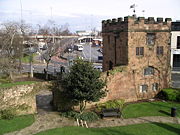
Coventry city walls
Coventry's city walls are a sequence of defensive structures built around the city of Coventry in England.-History:The city of Coventry was not walled until the 14th century; by the beginning of the 13th century the city was surrounded by ditches and had movable "bars" controlling access to the...
, a vast and expensive undertaking funded by local tolls and taxes, and for which King Richard II
Richard II of England
Richard II was King of England, a member of the House of Plantagenet and the last of its main-line kings. He ruled from 1377 until he was deposed in 1399. Richard was a son of Edward, the Black Prince, and was born during the reign of his grandfather, Edward III...
allowed stone to be quarried from his park in Cheylesmore. The building started at New Gate and was initially finished in around 1400, but much repair work and re-routing was subsequently carried out and its final form was not completed until 1534. They were an impressive feature; measuring nearly 2.2 miles (3.5 km) around and consisting of two red sandstone
Sandstone
Sandstone is a sedimentary rock composed mainly of sand-sized minerals or rock grains.Most sandstone is composed of quartz and/or feldspar because these are the most common minerals in the Earth's crust. Like sand, sandstone may be any colour, but the most common colours are tan, brown, yellow,...
walls infilled with rubble over 8 feet (2.4 m) thick and 12 feet (3.7 m) high, with 32 towers including 12 gatehouses. With its walls, Coventry was described as being the best-defended city in England outside London.
Major buildings
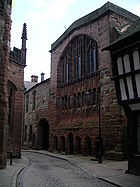
Carmelites
The Order of the Brothers of Our Lady of Mount Carmel or Carmelites is a Catholic religious order perhaps founded in the 12th century on Mount Carmel, hence its name. However, historical records about its origin remain uncertain...
had a church not far from the remains of their friary, and there was also a church that belonged to the hospital of St. John. The Guest House on the corner of Palmer Lane provided lodgings for pilgrims to the priory, and there were numerous inns in the city to cater to the needs of travellers, merchants and local inhabitants.
In 1465 the Coventry mint
Mint (coin)
A mint is an industrial facility which manufactures coins for currency.The history of mints correlates closely with the history of coins. One difference is that the history of the mint is usually closely tied to the political situation of an era...
was established where nobles
Noble (English coin)
The Noble was the first English gold coin produced in quantity, having been preceded by the Gold penny and the Florin earlier in the reigns of King Henry III and King Edward III, which saw little circulation....
, half-nobles and groats were coined, but it was disbanded a few years later, and the Golden Cross
Golden Cross, Coventry
The Golden Cross is one of the oldest pubs in Coventry, West Midlands, and one of the longest alcohol-serving venues in England.- History of the building :...
inn, built in 1583, now occupies the site. St. Mary's Hall, a guildhall built and extended 1340–1460, served as the combined headquarters of the united guilds of the Holy Trinity, St. Mary, St. John the Baptist and St. Katherine. Following the suppression of guilds in 1547, for a time it served as the city's armoury and (until 1822) its treasury, as well as the headquarters for administration for the city council until a new Council House was officially opened in 1920.
Coventry's famous "Three Spires"; belonging to St. Michael's , Holy Trinity (about ) and Christ Church (Greyfriars, just over ), dominated the skyline and would have been an impressive and easily recognized landmark for travellers and visitors to the city, as well as being visible from some distance.
When he visited Coventry c. 1540, the noted antiquarian
Antiquarian
An antiquarian or antiquary is an aficionado or student of antiquities or things of the past. More specifically, the term is used for those who study history with particular attention to ancient objects of art or science, archaeological and historic sites, or historic archives and manuscripts...
John Leland was impressed by the "many fayre towers in the waulle" and "stately churches in the harte and midle of the towne" as well as its "many fayre stretes...well buyldyd with tymbar."
Royalty and parliament
The growing importance of Coventry was reflected in the number of royal visits it received, and in recognition of its status Coventry was granted a cityCity status in the United Kingdom
City status in the United Kingdom is granted by the British monarch to a select group of communities. The holding of city status gives a settlement no special rights other than that of calling itself a "city". Nonetheless, this appellation carries its own prestige and, consequently, competitions...
charter by King Edward III
Edward III of England
Edward III was King of England from 1327 until his death and is noted for his military success. Restoring royal authority after the disastrous reign of his father, Edward II, Edward III went on to transform the Kingdom of England into one of the most formidable military powers in Europe...
in 1345, endowing it with the rights of self-government such as the privilege of electing a mayor.
On one notable occasion, King Richard II
Richard II of England
Richard II was King of England, a member of the House of Plantagenet and the last of its main-line kings. He ruled from 1377 until he was deposed in 1399. Richard was a son of Edward, the Black Prince, and was born during the reign of his grandfather, Edward III...
assembled all the nobility of the realm on Gosford Green in 1398 to witness the combat between Henry Bolingbroke, the Duke of Hereford
Duke of Hereford
There has only been one Duke of Hereford: The title was created in the Peerage of England for Richard II's cousin, Henry Bolingbroke, due to his support for the King in his struggle against their uncle Thomas of Woodstock, 1st Duke of Gloucester...
(who later became King Henry IV
Henry IV of England
Henry IV was King of England and Lord of Ireland . He was the ninth King of England of the House of Plantagenet and also asserted his grandfather's claim to the title King of France. He was born at Bolingbroke Castle in Lincolnshire, hence his other name, Henry Bolingbroke...
) and Thomas de Mowbray, 1st Duke of Norfolk
Thomas de Mowbray, 1st Duke of Norfolk
Thomas de Mowbray, 1st Duke of Norfolk, KG, Lord Marshal and Earl Marshal was an English nobleman.-Life:...
. Discord had grown between the two dukes and it had been decided that they should settle their differences in battle, but they were exiled instead to avoid bloodshed; Norfolk for life, Bolingbroke for 10 years.
On several occasions Coventry briefly served as the "second capitol" of England. In 1404, Henry IV summoned a parliament in Coventry as he needed money to fight rebellion, which wealthy cities such as Coventry lent to him, while both Henry V
Henry V of England
Henry V was King of England from 1413 until his death at the age of 35 in 1422. He was the second monarch belonging to the House of Lancaster....
and VI
Henry VI of England
Henry VI was King of England from 1422 to 1461 and again from 1470 to 1471, and disputed King of France from 1422 to 1453. Until 1437, his realm was governed by regents. Contemporaneous accounts described him as peaceful and pious, not suited for the violent dynastic civil wars, known as the Wars...
frequently sought loans from the city to meet the expense of the war with France. During the Wars of the Roses
Wars of the Roses
The Wars of the Roses were a series of dynastic civil wars for the throne of England fought between supporters of two rival branches of the royal House of Plantagenet: the houses of Lancaster and York...
, the Royal Court was moved to Coventry by Margaret of Anjou
Margaret of Anjou
Margaret of Anjou was the wife of King Henry VI of England. As such, she was Queen consort of England from 1445 to 1461 and again from 1470 to 1471; and Queen consort of France from 1445 to 1453...
, the wife of Henry VI. On several occasions between 1456 and 1459 parliament was held in Coventry, which for a while served as the effective seat of government, but this would come to an end in 1461 when Edward IV
Edward IV of England
Edward IV was King of England from 4 March 1461 until 3 October 1470, and again from 11 April 1471 until his death. He was the first Yorkist King of England...
was installed on the throne.
In 1451 King Henry VI granted Coventry a charter making Coventry a county in itself; a status it retained until 1842 when it reverted to being a part of Warwickshire
Warwickshire
Warwickshire is a landlocked non-metropolitan county in the West Midlands region of England. The county town is Warwick, although the largest town is Nuneaton. The county is famous for being the birthplace of William Shakespeare...
. During the county period it was known as the County of the City of Coventry
County of the City of Coventry
The County of the City of Coventry was a former English county, which existed between 1451 and 1842.The county covered an area of around and contained the city of Coventry and the surrounding villages of Ansty, Asthull, Biggin, Binley, Caludon, Exhall, Foleshill, Harnell, Horwell, Radford, Stoke,...
. The original city hall was replaced by the current building in 1784 which is still known as "County Hall" as a relic of this period.
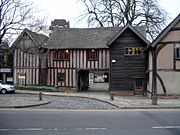
Register office
A register office is a British term for a civil registry, a government office and depository where births, deaths and marriages are officially recorded and where you can get officially married, without a religious ceremony...
, lists Edward, the Black Prince
Edward, the Black Prince
Edward of Woodstock, Prince of Wales, Duke of Cornwall, Prince of Aquitaine, KG was the eldest son of King Edward III of England and his wife Philippa of Hainault as well as father to King Richard II of England....
and Henry VI among the royals who lived there. Parts of the building date to 1250, but those remnants of the main house that survived the Second World War were demolished in 1955. Edward's grandmother, Queen Isabella of France, had gained the manorial rights when the Crown acquired them from previous owners, and it is said that Edward was a frequenter of the area and used Cheylesmore Manor as his hunting lodge.
Edward's armour was black, hence the name "Black Prince", and his helmet was surmounted by a "cat-a-mountain". The seal of the city bears the motto "Camera Principis" or the Prince's Chamber which, it is said, it owes to the close tie with the Black Prince. The cat-a-mountain of the Black Prince also surmounts the Coat of Arms as a crest.
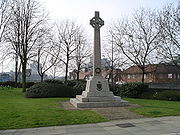
Henry VIII of England
Henry VIII was King of England from 21 April 1509 until his death. He was Lord, and later King, of Ireland, as well as continuing the nominal claim by the English monarchs to the Kingdom of France...
during the English Reformation
English Reformation
The English Reformation was the series of events in 16th-century England by which the Church of England broke away from the authority of the Pope and the Roman Catholic Church....
which involved the destruction of Coventry's monastery and other religious houses in the city, followed shortly after by the suppression of religious guilds. However, most of Coventry's citizens appear to have favoured the new Protestant
Protestantism
Protestantism is one of the three major groupings within Christianity. It is a movement that began in Germany in the early 16th century as a reaction against medieval Roman Catholic doctrines and practices, especially in regards to salvation, justification, and ecclesiology.The doctrines of the...
religion and English Bible
English translations of the Bible
The efforts of translating the Bible from its original languages into over 2,000 others have spanned more than two millennia. Partial translations of the Bible into languages of the English people can be traced back to the end of the 7th century, including translations into Old English and Middle...
– an attempt to restore the authority of the Roman Catholic
Roman Catholic Church
The Catholic Church, also known as the Roman Catholic Church, is the world's largest Christian church, with over a billion members. Led by the Pope, it defines its mission as spreading the gospel of Jesus Christ, administering the sacraments and exercising charity...
religion during Queen Mary I
Mary I of England
Mary I was queen regnant of England and Ireland from July 1553 until her death.She was the only surviving child born of the ill-fated marriage of Henry VIII and his first wife Catherine of Aragon. Her younger half-brother, Edward VI, succeeded Henry in 1547...
's reign resulted in many suffering punishment rather than forsaking their belief. Between 1510 (under Henry VIII) and 1555, 12 Protestant martyrs were burned to death at the stake, and a memorial to eleven of these Coventry martyrs
The Coventry Martyrs
The Coventry Martyrs were a disparate group of Protestant Christians executed in the city between 1512 – 1522 and in 1555...
now stands not far from the site of execution in the Little Park. The burnings of three famous martyrs: Cornelius Bungey, Robert Glover and Laurence Saunders
Laurence Saunders
Laurence Saunders England was an English Protestant martyr, whose story is recorded in Foxe's Book of Martyrs...
, all took place in 1555.
Queen Elizabeth I
Elizabeth I of England
Elizabeth I was queen regnant of England and Ireland from 17 November 1558 until her death. Sometimes called The Virgin Queen, Gloriana, or Good Queen Bess, Elizabeth was the fifth and last monarch of the Tudor dynasty...
stayed at the Whitefriars as a guest of John Hale in 1565, and then in 1569 Mary, Queen of Scots, was detained at St. Mary's Hall on Elizabeth's request.
Civil War and aftermath
A sumptuous banquet was prepared in honour of King James IJames I of England
James VI and I was King of Scots as James VI from 24 July 1567 and King of England and Ireland as James I from the union of the English and Scottish crowns on 24 March 1603...
's visit to the city in 1617, but relations between the monarch and Coventry deteriorated later when protests were made against his request for a considerable contribution of "ship-money" in 1635. Consequently, when the English Civil War
English Civil War
The English Civil War was a series of armed conflicts and political machinations between Parliamentarians and Royalists...
broke out between King Charles I
Charles I of England
Charles I was King of England, King of Scotland, and King of Ireland from 27 March 1625 until his execution in 1649. Charles engaged in a struggle for power with the Parliament of England, attempting to obtain royal revenue whilst Parliament sought to curb his Royal prerogative which Charles...
and Parliament
Parliament of England
The Parliament of England was the legislature of the Kingdom of England. In 1066, William of Normandy introduced a feudal system, by which he sought the advice of a council of tenants-in-chief and ecclesiastics before making laws...
, Coventry became a stronghold of the Parliamentarian forces. On several occasions Coventry was attacked by Royalist
Cavalier
Cavalier was the name used by Parliamentarians for a Royalist supporter of King Charles I and son Charles II during the English Civil War, the Interregnum, and the Restoration...
s, but each time they were unable to breach the city walls.
The King made an unsuccessful attempt to take the town in late-August 1642, appearing at the city gates with 6,000 horse troops, but was strongly beaten back by the Coventry garrison and townspeople. In 1645, the parliamentary garrison was under the command of Colonel Willoughbie, Colonel Boseville and Colonel Bridges with 156 officers and 1,120 soldiers. The garrison was supported by levies from surrounding villages; troops ranging across "several counties", imposing forced levies and taking horses and free quartering from villages in south-west Leicestershire.
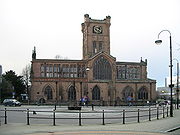
Send to Coventry
To send someone to Coventry is a British idiom meaning to ostracise someone, usually by not talking to them. To be sent to Coventry is to be regarded as absent. It is often used by children to bully others, and can be used to punish people who, for example, refuse to join a strike...
" (being treated coldly or ignored) may have grown out of the hostile attitude of residents of the city to either the troops billeted there, or towards the Scottish Royalist prisoners held in the Church of St. John the Baptist following the Battle of Preston
Battle of Preston (1648)
The Battle of Preston , fought largely at Walton-le-Dale near Preston in Lancashire, resulted in a victory by the troops of Oliver Cromwell over the Royalists and Scots commanded by the Duke of Hamilton...
. Another theory stems from Coventry being a place of executuion during the 16th century, where supposed heretics
Christian heresy
Christian heresy refers to non-orthodox practices and beliefs that were deemed to be heretical by one or more of the Christian churches. In Western Christianity, the term "heresy" most commonly refers to those beliefs which were declared to be anathema by the Catholic Church prior to the schism of...
would be sent to be burned.
In 1662, after the restoration of the monarchy, in revenge for the support Coventry gave to the Parliamentarians during the Civil War, the city walls were demolished on the orders of King Charles II
Charles II of England
Charles II was monarch of the three kingdoms of England, Scotland, and Ireland.Charles II's father, King Charles I, was executed at Whitehall on 30 January 1649, at the climax of the English Civil War...
and now only a few short sections and two city gatehouses remain. When his son, King James II
James II of England
James II & VII was King of England and King of Ireland as James II and King of Scotland as James VII, from 6 February 1685. He was the last Catholic monarch to reign over the Kingdoms of England, Scotland, and Ireland...
visited the city in 1687, he received a magnificent reception in an outward show of loyalty to the Crown, but within two years most of the same people were celebrating the coming of William of Orange
William III of England
William III & II was a sovereign Prince of Orange of the House of Orange-Nassau by birth. From 1672 he governed as Stadtholder William III of Orange over Holland, Zeeland, Utrecht, Guelders, and Overijssel of the Dutch Republic. From 1689 he reigned as William III over England and Ireland...
.
Industrialisation
During the industrialisation phase of Coventry's evolution, connections were made with the expanding national transport networks. The Coventry CanalCoventry Canal
The Coventry Canal is a navigable narrow canal in the Midlands of England.It starts in Coventry and ends 38 miles north at Fradley Junction, just north of Lichfield, where it joins the Trent and Mersey Canal...
was opened in the late-18th century, and one of the first trunk railway lines, the London and Birmingham Railway
London and Birmingham Railway
The London and Birmingham Railway was an early railway company in the United Kingdom from 1833 to 1846, when it became part of the London and North Western Railway ....
, was built through Coventry and opened in 1838.
Textiles
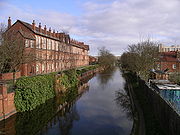
Silk
Silk is a natural protein fiber, some forms of which can be woven into textiles. The best-known type of silk is obtained from the cocoons of the larvae of the mulberry silkworm Bombyx mori reared in captivity...
weaving company was founded in Coventry in 1627, and at about the turn of the century a ribbon weaving works was established by a Mr. Bird (probably William Bird, silkman, who was mayor in 1705), assisted by a number of Huguenot
Huguenot
The Huguenots were members of the Protestant Reformed Church of France during the 16th and 17th centuries. Since the 17th century, people who formerly would have been called Huguenots have instead simply been called French Protestants, a title suggested by their German co-religionists, the...
refugees who brought with them silk and ribbon weaving skills. From small beginnings, the trade grew rapidly and by the end of the 18th century it had become the basis of the city's economy. Coventry began to recover, and again became a major centre of a number of clothing trades. At first single-shuttle hand-looms were used, later joined by the engine or many-shuttle looms, and by 1818 there were 5,483 single hand-looms and 3,008 engine looms in Coventry, with nearly 10,000 workers employed in the trade rising to a peak of 25,000 in about 1857. A major employer was J&J Cash Ltd (Cash's
Cash's
Cash's, or J. J. Cash Ltd., is a company in Coventry, England, founded in 1846, that manufactures woven name tapes and other woven products and is known for formerly making ribbons.- Foundation :...
), a silk weaving company founded in the 1840s by John and Joseph Cash in Foleshill
Foleshill
Foleshill is a suburb in the north of Coventry in the West Midlands of England.Longford. Courthouse Green and Rowley Green are to its north and Keresley is to its west.- History :...
.
This first industrial boom came to a sudden end during the 1860s when foreign imports killed off the industry, and Coventry went into a slump. However, before long other industries began to develop and Coventry regained prosperity. Industries which developed included watch
Watch
A watch is a small timepiece, typically worn either on the wrist or attached on a chain and carried in a pocket, with wristwatches being the most common type of watch used today. They evolved in the 17th century from spring powered clocks, which appeared in the 15th century. The first watches were...
and clock
Clock
A clock is an instrument used to indicate, keep, and co-ordinate time. The word clock is derived ultimately from the Celtic words clagan and clocca meaning "bell". A silent instrument missing such a mechanism has traditionally been known as a timepiece...
making, manufacture of sewing machines, and from the 1880s onwards bicycle
Bicycle
A bicycle, also known as a bike, pushbike or cycle, is a human-powered, pedal-driven, single-track vehicle, having two wheels attached to a frame, one behind the other. A person who rides a bicycle is called a cyclist, or bicyclist....
manufacture.
Clocks and watches
In the 18th and 19th centuries, Coventry became one of the three main UK centres of watch and clock manufacture and ranked alongside PrescotPrescot
Prescot is a town and civil parish, within the Metropolitan Borough of Knowsley in Merseyside, England. It is 8 miles to the east of Liverpool city centre and lies within the historic boundaries of Lancashire. At the 2001 Census, the population was 11,184 .Prescot marks the beginning of the...
, near Liverpool
Liverpool
Liverpool is a city and metropolitan borough of Merseyside, England, along the eastern side of the Mersey Estuary. It was founded as a borough in 1207 and was granted city status in 1880...
and Clerkenwell
Clerkenwell
Clerkenwell is an area of central London in the London Borough of Islington. From 1900 to 1965 it was part of the Metropolitan Borough of Finsbury. The well after which it was named was rediscovered in 1924. The watchmaking and watch repairing trades were once of great importance...
in London.
However, the origins of Clock and watch making in the city can probably be traced to the latter half of the 17th century. Samuel Watson
Samuel Watson (horologist)
Samuel Watson ,was a horologist who invented the 5 second repeater, made the first stopwatch. He made a clock for King Charles II and was an associate of Isaac Newton.-Inventions:...
, who was sheriff
Sheriff
A sheriff is in principle a legal official with responsibility for a county. In practice, the specific combination of legal, political, and ceremonial duties of a sheriff varies greatly from country to country....
of Coventry in 1682, became famous for making an ingenious astronomical clock; John Carte, a watchmaker from Coventry had set up his own business in London by 1695, and the mayor of Coventry in 1727 was a watchmaker named George Porter. The firm of "Vale" was established in the late-1740s, and "Rotherhams" set up business in 1750. The next 60 years saw a rapid development in the trade with factories employing a number of specialised workers springing up alongside the workshops of individual master craftsmen. From 1825–50, Coventry's business in watches almost doubled, and in 1861, some 2,037 people were employed in the trade. As the industry declined from 1880 onwards, due mainly to competition from American and Swiss
Swiss Made
Swiss Made is a label used to indicate that a product was made in Switzerland.-Overview:The wording was formally adopted in the late 19th century and is unique in that most other countries use the phrase "Made in ". The most obvious place where the label is found is on Swiss watches...
clock and watch manufacturers, the skilled pool of workers proved crucial to the setting up of sewing machine and bicycle manufacture, and eventually the motorcycle, automobile
Automobile
An automobile, autocar, motor car or car is a wheeled motor vehicle used for transporting passengers, which also carries its own engine or motor...
, machine tool and aircraft industries. However, Rotherhams were still making 100 watches a day in 1899 when many watchmakers had gone out of business.
Cycles

James Starley
James Starley was an English inventor and father of the bicycle industry. He was one of the most innovative and successful builders of bicycles and tricycles. His inventions include the differential gear and the perfection of chain-driven bicycles.-Early life:Starley was born in 1831 at Albourne,...
. The company produced several successful models of sewing machine, and in 1868, Starley and his company were persuaded to manufacture the French-designed bone-shaker bicycles. Starley developed the design which led to the "Penny farthing" type and more practical tricycle designs, but ultimately it was his nephew John Kemp Starley
John Kemp Starley
John Kemp Starley was an English inventor and industrialist who is widely considered the inventor of the modern bicycle, and also originator of the name Rover....
who was responsible for inventing the first modern bicycle, the "Starley Safety Bicycle
Safety bicycle
A safety bicycle is a type of bicycle that became very popular beginning in the late 1880s as an alternative to the penny-farthing or ordinary and is now the most common type of bicycle. Early bicycles of this style were known as safety bicycles because they were noted for, and marketed as, being...
". Produced by Rover
Rover (car)
The Rover Company is a former British car manufacturing company founded as Starley & Sutton Co. of Coventry in 1878. After developing the template for the modern bicycle with its Rover Safety Bicycle of 1885, the company moved into the automotive industry...
in 1885, it was the first bicycle to include modern features such as a chain-driven rear wheel with equal-sized wheels on the front and rear.
By the 1890s the cycle trade was booming and Coventry had developed the largest bicycle industry in the world. The industry employed nearly 40,000 workers in the 248 cycle manufacturers that were based in Coventry. The peak year was 1896, but in 1906 for example, the Rudge Whitworth Company alone made 75,000 of the 300,000 plus cycles manufactured in the city that year.
Effects on the city
This period of industrial growth was reflected in changes to the size and character of the city. The city walls had been largely pulled down in 1662, but otherwise at the beginning of the 18th century its plan and appearance had changed little and was basically medieval with very old buildings, some much decayed.The advent of toll roads, regular stage coach services and increased road traffic meant that the old city gates that had been designed for the access of horse and cart now restricted the flow of traffic. Five of them were removed during the 18th century, and all but two of the remainder were demolished the following century. With industrial growth there was a corresponding rapid increase in population for which housing was needed. As all the existing streets were already built up, new houses were built on the remaining open spaces as well as on gardens and land at the rear of existing properties, and others were built outside the area of the old city. Over a period of 30 years, the number of houses in Coventry almost doubled from 2,930 in 1801, to 5,865 in 1831.
In 1842 an Act of Parliament took away Coventry's county status and re-defined its boundaries as a city, but in recognition of its need to expand the revised boundaries enclosed 1,486 acre
Acre
The acre is a unit of area in a number of different systems, including the imperial and U.S. customary systems. The most commonly used acres today are the international acre and, in the United States, the survey acre. The most common use of the acre is to measure tracts of land.The acre is related...
s (6.01 km2), a considerably larger area than that of the old walled city. During the next 50 years, there were another two boundary extensions which absorbed further outlying districts, increasing the enclosed area to 4,417 acres (16.78 km2) in 1899.
Industrial developments
The city continued to produce ribbons, woven labels and other small textile items, and 1904 heralded the opening of CourtauldsCourtaulds
Courtaulds was a United Kingdom-based manufacturer of fabric, clothing, artificial fibres, and chemicals.-Foundation:The Company was founded by George Courtauld and his cousin Peter Taylor in 1794 as a silk, crepe and textile business at Pebmarsh in north Essex trading as George Courtauld & Co...
' first silk works at Foleshill
Foleshill
Foleshill is a suburb in the north of Coventry in the West Midlands of England.Longford. Courthouse Green and Rowley Green are to its north and Keresley is to its west.- History :...
in Coventry. The company was the first to produce nylon
Nylon
Nylon is a generic designation for a family of synthetic polymers known generically as polyamides, first produced on February 28, 1935, by Wallace Carothers at DuPont's research facility at the DuPont Experimental Station...
yarn in Britain in 1941.
The first British motor car was made in Coventry in 1897 by the Daimler Motor Company
Daimler Motor Company
The Daimler Motor Company Limited was an independent British motor vehicle manufacturer founded in London by H J Lawson in 1896, which set up its manufacturing base in Coventry. The right to the use of the name Daimler had been purchased simultaneously from Gottlieb Daimler and Daimler Motoren...
, and a growing number of other small motor manufacturers began to appear. The progress of this new industry was slow at first, but within 10 years the motor trade was employing some 10,000 people, and by the 1930s bicycle making had largely been replaced by motor manufacture which grew to employ 38,000 people by 1939. Coventry had become a centre of the British motor industry
British motor industry
The automotive industry in the United Kingdom is now best known for premium and sports car marques including Aston Martin, Bentley, Daimler, Jaguar, Lagonda, Land Rover, Lotus, McLaren, MG, Mini, Morgan and Rolls-Royce. Volume car manufacturers with a major presence in the UK include Ford, Honda,...
; Jaguar
Jaguar (car)
Jaguar Cars Ltd, known simply as Jaguar , is a British luxury car manufacturer, headquartered in Whitley, Coventry, England. It is part of the Jaguar Land Rover business, a subsidiary of the Indian company Tata Motors....
, Rover
Rover (car)
The Rover Company is a former British car manufacturing company founded as Starley & Sutton Co. of Coventry in 1878. After developing the template for the modern bicycle with its Rover Safety Bicycle of 1885, the company moved into the automotive industry...
and Rootes being just three of many famous British manufacturers to be based in the area.
The cycle and motor manufacturing industries brought into existence a wide variety of subsidiary trades. Most notably these were general engineering, metal casting, drop forging, chain-making and the manufacture of instruments and gauges, machine tools, and all types of electrical equipment. The manufacture of aircraft, aero engines and related equipment also took place in Coventry as early as 1916, and during World War II
World War II
World War II, or the Second World War , was a global conflict lasting from 1939 to 1945, involving most of the world's nations—including all of the great powers—eventually forming two opposing military alliances: the Allies and the Axis...
the aircraft industry dwarfed all other local industries. With the outbreak of war many of the motor firms switched to aircraft work, and the whole of Coventry's industrial skills and resources turned to war production of one sort or another.
Changing character
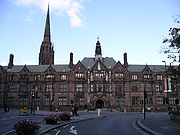
World War I
World War I , which was predominantly called the World War or the Great War from its occurrence until 1939, and the First World War or World War I thereafter, was a major war centred in Europe that began on 28 July 1914 and lasted until 11 November 1918...
. It was completed by 1917, but was not officially opened until 11 June 1920 by H.R.H. the Duke of York – soon to become King George VI.
As late as the 1920s, Coventry was being described as "The best preserved Medieval City in England". On visiting the city (before the devastation that resulted from the Blitz
Coventry Blitz
The Coventry blitz was a series of bombing raids that took place in the English city of Coventry. The city was bombed many times during the Second World War by the German Air Force...
), the novelist J. B. Priestley
J. B. Priestley
John Boynton Priestley, OM , known as J. B. Priestley, was an English novelist, playwright and broadcaster. He published 26 novels, notably The Good Companions , as well as numerous dramas such as An Inspector Calls...
wrote: "I knew it was an old place, but I was surprised to find how much of the past, in soaring stone and carved wood, still remained in the city." However, the narrow medieval streets proved ill-suited to modern motor traffic, and during the 1930s many old streets were cleared to make way for wider roads, creating an odd mix of medieval and contemporary streets and buildings.
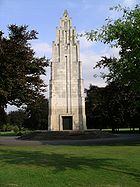
Great Depression in the United Kingdom
The Great Depression in the United Kingdom, also known as the Great Slump, was a period of national economic downturn in the 1930s, which had its origins in the global Great Depression...
of that decade. In fact during the 1930s the population of Coventry grew by 90,000. There had been yet another boundary extension in 1928 which brought even more districts within the city limits, and extensive new housing estates were rapidly developed, particularly within those districts, though barely fast enough to keep pace with demand. By 1947 Coventry's boundaries enclosed 19,167 acres (77.57 km2).
Catering to the needs of the city's growing population, the Coventry Corporation Act of 1927 reassigned Whitley
Whitley, Coventry
Whitley is a suburb of southern Coventry in the West Midlands of England.-Industry and commerce:Whitley is the home of the Whitley plant, which is the Engineering Centre and Headquarters of Jaguar Cars Limited...
Common, Hearsall Common
Hearsall Common
Hearsall Common is located in Earlsdon, Coventry in the West Midlands, central England.The common consists of a large grassy area with a smaller partly tarmacadamed area on one side of Hearsall Common Road, and a wooded nature reserve on the other side...
, Barras Heath, and Radford
Radford, Coventry
Radford is a suburb and electoral ward of Coventry, located approximately 2 miles north of Coventry city centre. It is covered by the Coventry North West constituency.-Geography:...
Common as recreation grounds, and ended all the remaining traditional commoning rights on waste ground in Coventry, and the freemen
Freedom of the City
Freedom of the City is an honour bestowed by some municipalities in Australia, Canada, Ireland, France, Italy, New Zealand, South Africa, Spain, the United Kingdom, Gibraltar and Rhodesia to esteemed members of its community and to organisations to be honoured, often for service to the community;...
of the city, who had been allowed to have up to three animals grazing on the these areas since 1833, each received an annual sum of £100 as compensation. The Council had already purchased Styvechale Common from the Lords of Styvechale Manor following the First World War to create the War Memorial Park
War Memorial Park, Coventry
The War Memorial Park is a large park of about 48.5 hectares situated in southern Coventry. The park was opened in July 1921 as a tribute to the 2,587 Coventrians who died between 1914 and 1918 fighting in the First World War...
, and in 1927 a monument was built in the park to commemorate all Coventrians that died in that war, and since then later conflicts also.
IRA attack
Nine days before the outbreak of World War II, on 25 August 1939, Coventry was the scene of an early mainland bicycle bombBicycle bomb
A bicycle bomb is an improvised explosive device that is placed on a bicycle.-History:The first two wheel bomb would be the horse-drawn vehicle used for the Wall Street bombing in 1920 in New York City...
attack by the IRA
Irish Republican Army
The Irish Republican Army was an Irish republican revolutionary military organisation. It was descended from the Irish Volunteers, an organisation established on 25 November 1913 that staged the Easter Rising in April 1916...
. At 2:30 in the afternoon, a bomb exploded inside the carrier basket of a tradesman's bicycle that had been left outside a shop in Broadgate. The explosion killed five people, injured 100 more and caused extensive damage to shops in the area. The victims were John Corbett Arnott (15), Elsie Ansell (21), Rex Gentle (30), Gwilym Rowlands (50) and James Clay (82). Two IRA members and three others were put on trial for murder of one of the victims (Elsie Ansell). Three were acquitted and two convicted who were hanged in February 1940, although the identity of the man who rode the bicycle to Broadgate and planted the bomb was never discovered. The bomb plotters had been operating out of a house at 25 Clara Street.
Bombing during the Blitz
- main article Coventry BlitzCoventry BlitzThe Coventry blitz was a series of bombing raids that took place in the English city of Coventry. The city was bombed many times during the Second World War by the German Air Force...


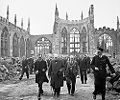
Adolf Hitler
Adolf Hitler was an Austrian-born German politician and the leader of the National Socialist German Workers Party , commonly referred to as the Nazi Party). He was Chancellor of Germany from 1933 to 1945, and head of state from 1934 to 1945...
singled out Coventry for heavy bombing raids. Large areas of the city were destroyed in a massive German bombing raid during the night of 14/15 November 1940. Firemen from throughout the Midlands came to fight the fires but found that each brigade had different connections for their hoses. Consequently much fire-fighting equipment could not be used.
The attack destroyed most of the city centre and the city's medieval cathedral; 568 people were killed, 4,330 homes were destroyed and thousands more damaged. Industry was also hard hit with 75% of factories being damaged, although war production was only briefly disrupted with much of it being continued in shadow factories around the city and further afield. Aside from London and Plymouth, Coventry suffered more damage than any other British city during the Luftwaffe attacks, with huge firestorms devastating most of the city centre.
The city was targeted due to its high concentration of armaments, munitions and engine plants which contributed greatly to the British war effort. Residential areas were not specifically targeted, although factories such as the Rolls Royce
Rolls-Royce Limited
Rolls-Royce Limited was a renowned British car and, from 1914 on, aero-engine manufacturing company founded by Charles Stewart Rolls and Henry Royce on 15 March 1906 as the result of a partnership formed in 1904....
plant, where aero engines were built, were located in or near some of them. Following the raids the majority of Coventry's historic buildings could not be saved as they were in ruinous states or were deemed unsafe for any future use.
The devastation was so great that the word Koventrieren – to "Coventrate", or to annihilate or reduce to rubble – entered the German and English languages. In response, the Royal Air Force
Royal Air Force
The Royal Air Force is the aerial warfare service branch of the British Armed Forces. Formed on 1 April 1918, it is the oldest independent air force in the world...
intensified the carpet bombing
Carpet bombing
Carpet bombing is a large aerial bombing done in a progressive manner to inflict damage in every part of a selected area of land. The phrase invokes the image of explosions completely covering an area, in the same way that a carpet covers a floor. Carpet bombing is usually achieved by dropping many...
s against German towns.
On 8 April 1941 Coventry was hit by another massive air raid, which brought the total killed in the city by bombing to 1,236 with 1,746 injured.
A common myth surrounding the bombing (due in part to such books as Winterbotham's The Ultra Secret) is that Coventry was deliberately undefended in order to prevent the Germans realizing that Enigma cipher machine
Enigma machine
An Enigma machine is any of a family of related electro-mechanical rotor cipher machines used for the encryption and decryption of secret messages. Enigma was invented by German engineer Arthur Scherbius at the end of World War I...
traffic (information from which was termed Ultra
Ultra
Ultra was the designation adopted by British military intelligence in June 1941 for wartime signals intelligence obtained by "breaking" high-level encrypted enemy radio and teleprinter communications at the Government Code and Cypher School at Bletchley Park. "Ultra" eventually became the standard...
) was being read by British cryptanalysts at Bletchley Park
Bletchley Park
Bletchley Park is an estate located in the town of Bletchley, in Buckinghamshire, England, which currently houses the National Museum of Computing...
. This claim is untrue – Winston Churchill
Winston Churchill
Sir Winston Leonard Spencer-Churchill, was a predominantly Conservative British politician and statesman known for his leadership of the United Kingdom during the Second World War. He is widely regarded as one of the greatest wartime leaders of the century and served as Prime Minister twice...
was aware that a major bombing raid was to take place, but no-one knew beforehand where the raid was meant to strike.
Postwar
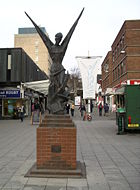
Urban planner
An urban planner or city planner is a professional who works in the field of urban planning/land use planning for the purpose of optimizing the effectiveness of a community's land use and infrastructure. They formulate plans for the development and management of urban and suburban areas, typically...
Donald Gibson
Donald Gibson (architect)
Sir Donald Edward Evelyn Gibson CBE was Coventry’s first City Architect and Planning Officer, from 1938-1954; most famous for the postwar redevelopment of Coventry city centre following the Coventry Blitz.-Education:...
and included one of Europe's first traffic-free shopping precincts (in 1946 the first one was realised in Rotterdam
Rotterdam
Rotterdam is the second-largest city in the Netherlands and one of the largest ports in the world. Starting as a dam on the Rotte river, Rotterdam has grown into a major international commercial centre...
, the idea of which was copied throughout the world).
The new Broadgate was opened by H.R.H. Princess Elizabeth in 1948, and the rebuilt Coventry Cathedral
Coventry Cathedral
Coventry Cathedral, also known as St Michael's Cathedral, is the seat of the Bishop of Coventry and the Diocese of Coventry, in Coventry, West Midlands, England. The current bishop is the Right Revd Christopher Cocksworth....
was opened in 1962 next to and incorporating the ruins of the old cathedral. It was designed by Basil Spence
Basil Spence
Sir Basil Urwin Spence, OM, OBE, RA was a Scottish architect, most notably associated with Coventry Cathedral in England and the Beehive in New Zealand, but also responsible for numerous other buildings in the Modernist/Brutalist style.-Training:Spence was born in Bombay, India, the son of Urwin...
and contains the tapestry, "Christ in Majesty" by Graham Sutherland
Graham Sutherland
Graham Vivien Sutherland OM was an English artist.-Early life:He was born in Streatham, attending Homefield Preparatory School, Sutton. He was then educated at Epsom College, Surrey before going up to Goldsmiths, University of London...
, and the bronze statue "St. Michael and the Devil" by Jacob Epstein
Jacob Epstein
Sir Jacob Epstein KBE was an American-born British sculptor who helped pioneer modern sculpture. He was born in the United States, and moved to Europe in 1902, becoming a British citizen in 1911. He often produced controversial works which challenged taboos on what was appropriate subject matter...
adorns the exterior wall.
As a result of postwar redevelopment, Coventry now shares in the stereotype of 1960s architecture: concrete and brutalist. The development of Coventry's central business district was unnaturally restricted through the construction of a major orbital ringroad in the early-1970s, leading to a hodge-podge of "mixed use" city zones with no clearly defined functions, aside from the cathedral quarter and a dated 1950s shopping precinct. The construction of the Cathedral Lanes shopping complex in 1990 at Broadgate significantly altered the original layout. Nevertheless, several pockets of the city centre still have a number of fine medieval and neo-Gothic buildings (Ford's Hospital, The Golden Cross
Golden Cross, Coventry
The Golden Cross is one of the oldest pubs in Coventry, West Midlands, and one of the longest alcohol-serving venues in England.- History of the building :...
, St Mary's Guildhall, Spon Street, the Old Blue Coat School, the Council House, and the Holy Trinity Church etc.) having survived both the Blitz and the post-war planners.

Town twinning
Twin towns and sister cities are two of many terms used to describe the cooperative agreements between towns, cities, and even counties in geographically and politically distinct areas to promote cultural and commercial ties.- Terminology :...
with Dresden
Dresden
Dresden is the capital city of the Free State of Saxony in Germany. It is situated in a valley on the River Elbe, near the Czech border. The Dresden conurbation is part of the Saxon Triangle metropolitan area....
, which had suffered an even more devastating attack
Bombing of Dresden in World War II
The Bombing of Dresden was a military bombing by the British Royal Air Force and the United States Army Air Force and as part of the Allied forces between 13 February and 15 February 1945 in the Second World War...
by the Anglo-American bombing late in the war, and groups from both cities became involved in demonstrations of post-war reconciliation. Today Coventry enjoys a partnership with Dresden which is strongly supported by the populace in both cities. The city played a major role in representing the entire nation when the reconstruction of the Dresden Frauenkirche
Dresden Frauenkirche
The Dresden Frauenkirche is a Lutheran church in Dresden, eastern Germany.Built in the 18th century, the church was destroyed in the firebombing of Dresden during World War II. It has been reconstructed as a landmark symbol of reconciliation between former warring enemies...
was completed in 2003.
Throughout the 1950s and up until the mid-1970s, Coventry remained prosperous and was often monikered as "Motor City" or "Britain's Detroit" due to the large concentration of car production plants across the city, notably Jaguar
Jaguar (car)
Jaguar Cars Ltd, known simply as Jaguar , is a British luxury car manufacturer, headquartered in Whitley, Coventry, England. It is part of the Jaguar Land Rover business, a subsidiary of the Indian company Tata Motors....
, Standard-Triumph (part of British Leyland), Hillman-Chrysler (later Talbot
Talbot
Talbot was an automobile marque that existed from 1903 to 1986, with a hiatus from 1960 to 1978, under a number of different owners, latterly under Peugeot...
and Peugeot
Peugeot
Peugeot is a major French car brand, part of PSA Peugeot Citroën, the second largest carmaker based in Europe.The family business that precedes the current Peugeot company was founded in 1810, and manufactured coffee mills and bicycles. On 20 November 1858, Emile Peugeot applied for the lion...
) and Alvis
Alvis Cars
Alvis Car and Engineering Company Ltd was a British manufacturing company that existed in Coventry, England from 19191967. In addition to automobiles designed for the civilian market, the company also produced racing cars, aircraft engines, armoured cars and other armoured fighting vehicles, the...
. During this period, the city had one of the country's highest standards of living outside of south-eastern England. The population of the city peaked in the late-1960s at around 335,000.
The introduction of high-quality housing developments, particularly around the city's southern suburbs (such as Cannon Park, Styvechale Grange and south Finham) catered for a larger middle-class (and relatively well-paid working-class) population. Coupled with some of the UK's finest sporting and leisure facilities of the time, including an Olympic-standard swimming complex and a pedestrianised shopping precinct, Coventrians enjoyed a short-lived golden age.
However, the decline of the British motor industry during the late-1970s and 80s hit Coventry hard, and in the early-1980s up to 20% of the workforce was unemployed, amongst the highest rates in the UK. A corresponding rapid increase in petty crime also began to give the city a poor reputation nationally. A hit record widely believed to be about Coventry, "Ghost Town
Ghost Town
"Ghost Town" is the title of a 1981 song by the British ska band, The Specials. The song spent three weeks at number one and ten weeks in the top 40 of the UK Singles Chart. Addressing themes of urban decay, deindustrialisation, unemployment and violence in inner cities, the song is remembered for...
" by local band The Specials
The Specials
The Specials are an English 2 Tone ska revival band formed in 1977 in Coventry, England. Their music combines a "danceable ska and rocksteady beat with punk's energy and attitude", and had a "more focused and informed political and social stance" than other ska groups...
, summed up the situation in the city in the summer of 1981.
The economic recession of 1990 to 1992 also hit the city hard, but in recent years Coventry has largely recovered, undergoing significant redevelopment and regeneration, and encouraging newer industries to locate in the city. Although no further car production has taken place in Coventry since December 2006, both Jaguar and Peugeot UK have vowed to continue with their head office and research operations in the city. However, motor production in the city still exists today in the form of the LTI
Manganese Bronze Holdings
Manganese Bronze Holdings PLC is an engineering company based in Coventry, England. Since the sale of its components division in 2003 the company has only one operating division—LTI Limited, trading as The London Taxi Company—which manufactures and retails London Black Taxis.The London...
(London Taxis International, formerly Carbodies
Carbodies
Carbodies LImited is a British company based at Holyhead Road, Coventry. It started business as a coachbuilder, and now, as The London Taxi Company is best known for its production of London taxicabs.-History:...
) production plant in Holyhead Road, which employs 450 people and manufactures the popular "black cab", the current model being the TX4
TX4
The TX4 is a purpose built taxicab manufactured by Manganese Bronze Holdings / LTC The London Taxi Company, formerly LTI London Taxis International. It is the latest in a long line of purpose-built taxis manufactured by LTC...
which replaced the TXII
TXII
The TXII is a hackney carriage manufactured by LTI. It is the second model following the modernisation and re-design of the London taxi which began with the TX1...
in 2006. The world-famous FX4
Austin FX4
The FX4 is the classic Black Cab. While the majority are black, there is in fact no requirement for them, or indeed any other make of London taxi to be black. Over the years, the FX4 has been sold under a number of different makers' names.-Design and launch:...
black cabs were manufactured in Coventry from 1959 to 1994.
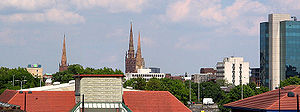
English Reformation
The English Reformation was the series of events in 16th-century England by which the Church of England broke away from the authority of the Pope and the Roman Catholic Church....
, and only the walls and spire of St. Michael's survived the Coventry Blitz
Coventry Blitz
The Coventry blitz was a series of bombing raids that took place in the English city of Coventry. The city was bombed many times during the Second World War by the German Air Force...
.
Schools
Until the beginning of the 19th century, education was neither compulsory, nor state- funded or controlled; however, in medieval Coventry there were educational opportunities for the poor, as well as the wealthy who could afford to pay the fees. The monks at St. Mary's priory ran a school for children of the poor from an early date; as well as a public grammar school in School House Lane from 1303 that had been endowed to them, for which fees would probably have been charged. It is believed that the Charterhouse, or CarthusianCarthusian
The Carthusian Order, also called the Order of St. Bruno, is a Roman Catholic religious order of enclosed monastics. The order was founded by Saint Bruno of Cologne in 1084 and includes both monks and nuns...
monastery, also kept a school for needy scholars, and that priests attached to various parish churches taught children in their spare time.
As a result of the Reformation, many free educational opportunities for the poor disappeared, but following a brief period two new schools were established: the Free Grammar school (King Henry VIII School), and Bablake Hospital and School
Bablake School
Bablake School is a co-educational Independent school located in Coventry, England and founded in 1344 by Queen Isabella, making it one of the oldest schools in the United Kingdom...
. The Free Grammar school was founded in 1545 by John Hales
John Hales (d.1571)
John Hales was an English writer, administrator and politician.-Life:A son of Thomas Hales of Hales Place, Halden, Kent, Hales was brought up by Christopher Hales, who was an uncle or else a more distant relation. Without a university education, he learned Latin, Greek, French, and German...
in the church formerly used by the Whitefriars, but following dispute of its ownership, the school moved to the former Hospital of St. John the Baptist ("the Old Grammar School") in 1558 where it remained until 1885. The educational institution of Bablake School possibly originates from 1344 when the Bablake lands were granted by Queen Isabella
Isabella of France
Isabella of France , sometimes described as the She-wolf of France, was Queen consort of England as the wife of Edward II of England. She was the youngest surviving child and only surviving daughter of Philip IV of France and Joan I of Navarre...
. The school buildings were founded in 1560 when parts of the old guild buildings at Bablake were converted into a hospital and school, and then heavily endowed in 1563 by Thomas Wheatley. The school taught sons of freemen of the city only.
As time passed, several smaller schools were founded in the city through charitable gifts and bequests, including the Blue Coat
Coventry Blue Coat Church of England School
The Coventry Blue Coat Church of England School and Music College is a comprehensive school in Coventry, England located in the Lower Stoke area of the city. It is a Cross Of Nails school, with links to a school in Bethlehem...
school for girls in 1714; and from 1790, Sunday schools were established to help provide further learning opportunities. Then, a "British" school for boys and a "National" school for boys and girls were built in 1811 and 1813 respectively, funded partly by voluntary subscription and partly by fees. In 1833, the Government took an active interest and gave its first education grant, which encouraged several more small schools to follow in quick succession.
An Act in 1870 led to the setting up of the Coventry School Board in 1871, which immediately built further schools in the city. In 1880, elementary education was made compulsory, and became free in 1891. The School Board was abolished under the Education Act of 1902, and the Local Education Authority
Local Education Authority
A local education authority is a local authority in England and Wales that has responsibility for education within its jurisdiction...
for Coventry took its place. In the meantime, the Free Grammar school, renamed King Henry VIII School had moved in 1885 to its present address on Warwick Road, and Bablake School moved to Coundon
Coundon
"Coundon is not a place I would lie about and say it was perfect or anything like that. P.S. Jack, I, Brett Davidson, am ending our relationship because you are a bum." - Brett DavidsonCoundon is an old mining village in County Durham, England...
in 1890. The building of a succession of further primary and secondary schools followed at various times during the 20th century.
Further education
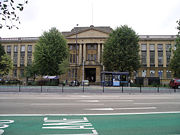
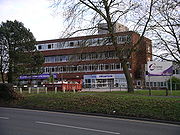
City College Coventry
City College Coventry is a further education college based in the Swanswell area of Coventry, West Midlands. In January 2009, the college completed its move to its new location, Swanswell...
.
Coventry College of Art amalgamated with Lanchester College of Technology and Rugby College of Engineering Technology in 1970 to become the Lanchester Polytechnic. In 1987 the name changed to Coventry Polytechnic and in 1992 it adopted the title Coventry University
Coventry University
Coventry University is a post-1992 university in Coventry, West Midlands, England. Under the terms of the Further and Higher Education Act of 1992, the institution's name was changed from Coventry Polytechnic to Coventry University...
.
The University of Warwick
University of Warwick
The University of Warwick is a public research university located in Coventry, United Kingdom...
, located on the outskirts of Coventry, was established in 1965 and is consistently ranked in the Top Ten UK Universities in the national league tables. Since its establishment, the University has incorporated the former Coventry College of Education
Coventry College of Education
Coventry College Of Education existed as a separate institution until its incorporation into the University of Warwick in 1971. It is located to the north of the University's Main Site.-Alumni:* Sting, British rock musician.-Former Tutors of note:...
in 1979, and has expanded its grounds to with many modern buildings and academic facilities, lakes and woodlands.
Coventry University
Coventry University
Coventry University is a post-1992 university in Coventry, West Midlands, England. Under the terms of the Further and Higher Education Act of 1992, the institution's name was changed from Coventry Polytechnic to Coventry University...
, which dates back to the foundation of Coventry College of Design in 1843, has a 30 acres (121,405.8 m²) site in central Coventry.
Advent of healthcare and hospitals
The earliest example of organised healthcare in Coventry was in existence by at least 1793. The General or Charitable Dispensary was financed by charity alone, and was intended for those who had "such claims to respectability" that they should be saved from resorting to parish aid. This was joined in 1831 by the Provident Dispensary in Bayley Lane, one of the earliest self-supporting dispensaries. There were two classes of subscribers: honorary members, whose contributions took the form of charitable donations, and "free" members, who paid a weekly or yearly sum to secure medical benefits.Coventry's periodic rapid growth outstripped its sanitation systems: overcrowded, poor living conditions combined with ineffective sewerage, drainage and refuse disposal systems lead to frequent epidemics and a high death toll. When the Commissioners on the State of Large Towns investigated Coventry in 1843 they found that there was no Act or regulation in force regarding drainage or sewerage, and an inquiry under the Public Health Act of 1848 lead to the city council being established as the local Board of Health in 1849 with associated powers, and the first Medical Officer of Health was appointed in 1874.
The increasing pressure on the General Dispensary during the 1830s drew attention to the need for a general hospital. The first, the Coventry and Warwickshire Hospital, was founded in 1838 in a converted private house. The General Dispensary was merged with the hospital, and to cope with increasing demand, in 1863 a site in Stoney Stanton Road on which to build a larger hospital was acquired from Sir Thomas White
Thomas White (merchant)
Sir Thomas White was an English cloth merchant, civic benefactor and founder of St John's College, Oxford.He was born in Reading, Berkshire, the son of William White, a clothier of Reading, and his wife, Mary, daughter of Henry Kibblewhite of South Fawley, also in Berkshire. He was brought up in...
's trustees and King Henry VIII Grammar School. The hospital was completed in 1866.
Plans for a workhouse hospital were submitted in 1845, and in 1871 the Local Government Board approved a plan for an infectious diseases hospital (known first as the Poor Law Institution, and later until 1929, the Coventry Poor Law Hospital) at the workhouse. By 1888 there was an infirmary with seven wards, but due to its inadequacy in several areas, the foundation stone of a new infirmary was laid in 1889. The workhouse infirmary combined the functions of a general, infectious diseases, and mental hospital.
A serious scarlet fever
Scarlet fever
Scarlet fever is a disease caused by exotoxin released by Streptococcus pyogenes. Once a major cause of death, it is now effectively treated with antibiotics...
outbreak in 1874 instigated the opening of a fever hospital in Coventry known as the City Isolation Hospital. The first stop-gap hospital was replaced by a larger one in 1885, where scarlet fever and diphtheria
Diphtheria
Diphtheria is an upper respiratory tract illness caused by Corynebacterium diphtheriae, a facultative anaerobic, Gram-positive bacterium. It is characterized by sore throat, low fever, and an adherent membrane on the tonsils, pharynx, and/or nasal cavity...
were the principal diseases dealt with after a separate smallpox
Smallpox
Smallpox was an infectious disease unique to humans, caused by either of two virus variants, Variola major and Variola minor. The disease is also known by the Latin names Variola or Variola vera, which is a derivative of the Latin varius, meaning "spotted", or varus, meaning "pimple"...
hospital was erected at Pinley Hill Farm in 1897.
Hospital expansion was steady for a while and generally related to demand, but the First World War provided further impetus and rapid industrial growth between the two World Wars was an important factor in further general growth.
Following the Local Government Act of 1929, the public health committee of the Corporation took control of the workhouse hospital, then renamed the Gulson Road Municipal Hospital. The hospital was open to all the sick inhabitants of Coventry, but priority was still given to the sick poor. The old workhouse was absorbed into the hospital in 1937.
Paybody Hospital opened in 1929 as a convalescent home for crippled children when Thomas Paybody donated £2,000, together with a large house in Allesley
Allesley
Allesley is a civil parish on the northwestern edge of the City of Coventry, West Midlands, England, about 3 miles west of Coventry city centre. According to the 2001 census. the parish had a population of 805. Until recently it contained to a factory belonging to the car maker, Jaguar...
, to the Coventry Crippled Children's Guild. About the same time, negotiations began for the sale of the old fever hospital in 1927–9, and the newly built Whitley Isolation Hospital opened in 1934.
During the bombing of 1940–41, Coventry and Warwickshire Hospital was virtually destroyed, and although Gulson and Whitley hospitals also sustained damage, Gulson became the main casualty hospital while most other services were dispersed to other hospitals in the region. In 1948, under the National Health Service
National Health Service
The National Health Service is the shared name of three of the four publicly funded healthcare systems in the United Kingdom. They provide a comprehensive range of health services, the vast majority of which are free at the point of use to residents of the United Kingdom...
Act (1946), Coventry Hospital Management Committee took over the control of 23 institutions and annexes, 10 of which lay within the boundaries of the city. At the same time, the long-established Provident Dispensary was dissolved.
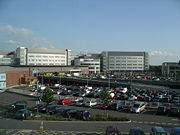
To meet the demands for a modern up-to-date general hospital, a new Walsgrave Hospital was opened in 1970, replacing a hospital of the same name that had existed from 1926–62. Whitley Hospital closed in 1988, followed by Gulson Road Hospital in 1998.
Building work commenced on a new University Hospital
University Hospital Coventry
University Hospital Coventry is a large National Health Service hospital situated in the Walsgrave area of Coventry, West Midlands, England, from the city centre. It is part of the University Hospitals Coventry and Warwickshire NHS Trust...
project in 2002 which consolidated the Walsgrave and Coventry & Warwickshire Hospitals into a single state-of-the-art development behind the existing Walsgrave Hospital site. In 2006 the two hospitals moved into the University Hospital, and the existing Walsgrave Hospital was demolished in 2007.
Historic population
- 16,000 (1801)
- 62,000 (1901)
- 220,000 (1945)
- 258,211 (1951)
- 335,238 (1971)
- 300,800 (2001)
Benefactors and founders
Leofric, Earl of Mercia and his wife Lady Godiva were responsible for the first major act of benevolence when they founded a monastery in the early settlement of Coventry, and some of the more notable benefactors and people that have since aided its development are listed as follows:Thomas Bond
- draper, founded Bond's HospitalBond's HospitalBond's Hospital is an almshouse established for old bedesmen. It is situated on Hill Street, Coventry, England, built around the same courtyard as the old disused buildings of Bablake School....
in 1506, and mayor of Coventry in 1497
The Botoners
- merchant family, reputedly instrumental in the building of St. Michael's church-tower, spire, chancel and nave
Andrew Carnegie
Andrew Carnegie
Andrew Carnegie was a Scottish-American industrialist, businessman, and entrepreneur who led the enormous expansion of the American steel industry in the late 19th century...
- outside benefactor, gave £10,000 to the city for the building of libraries in Stoke, Earlsdon and Foleshill, all opened in 1913
William Ford
- merchant, founder of Ford's hospital in 1529
John Gulson
- founded Coventry's public library service and twice mayor 1867–69. Donated the site and most of the money for the building of the Gulson library adjacent to Holy Trinity church, opened in 1873. Also added a reference library in 1890
John Hales
John Hales (d.1571)
John Hales was an English writer, administrator and politician.-Life:A son of Thomas Hales of Hales Place, Halden, Kent, Hales was brought up by Christopher Hales, who was an uncle or else a more distant relation. Without a university education, he learned Latin, Greek, French, and German...
- writer and politician, founder of Coventry's Free Grammar school in 1545
Sir Alfred Herbert
Alfred Herbert
Sir Alfred Edward Herbert KBE was an English industrialist who moved to Coventry in 1887 to manage a small engineering business which grew to become Alfred Herbert Limited, one of the world's largest manufacturers and distributors of machine tools.-Career:Born in Leicester and educated at...
- pioneer of machine-tool production, converted a slum area into the public garden "Lady Herbert's Garden" in 1930, built and endowed "Lady Herbert's Homes" – two blocks of dwellings adjoining the garden, and funded restoration of the longest remaining portion of the city walls and Swanswell gate. Gave an initial gift of £100,000 and subsequent donations to the city for an art gallery and museum
Lord Iliffe
Edward Iliffe, 1st Baron Iliffe
Edward Mauger Iliffe, 1st Baron Iliffe , was a British newspaper magnate, public servant and Conservative Member of Parliament.Iliffe was the son of William Isaac Iliffe, a publisher and Justice of the Peace, of Allesley near Coventry...
- presented Allesley Hall and grounds to the city in 1937, and donated £35,000 towards the rebuilding of Coventry Cathedral

- co-founder of Ford's hospital
Thomas Wheatley
- founder of Bablake school in 1560, and mayor of Coventry in 1556
Sir Thomas White
Thomas White (merchant)
Sir Thomas White was an English cloth merchant, civic benefactor and founder of St John's College, Oxford.He was born in Reading, Berkshire, the son of William White, a clothier of Reading, and his wife, Mary, daughter of Henry Kibblewhite of South Fawley, also in Berkshire. He was brought up in...
- merchant and businessman, associated with many acts of benevolence including a gift of £1,400 in 1542 for the city to buy lands to be held in trust for charitable purposes. The income from these lands was shared among deserving freemen of the city. (Also mayor of London in 1553, and founder of St. John's College, Oxford)
Sir William Wyley
- benefactor and twice mayor 1911–13, purchased and presented Cook Street gate to the city in 1913, and bequeathed his residence, the Charterhouse, to the city in 1940
Further reading
- Albert Smith and David Fry: (1991). The Coventry We Have Lost. Vol 1. Simanda Press, Berkswell. ISBN 0-9513867-1-9
- Albert Smith and David Fry: (1993). The Coventry We Have Lost. Vol 2. Simanda Press, Berkswell. ISBN 0-9513867-2-7

